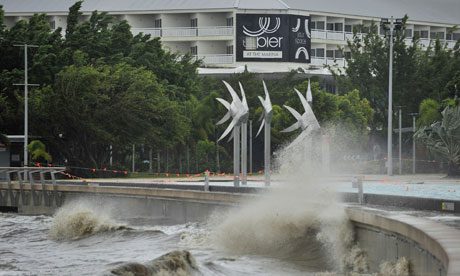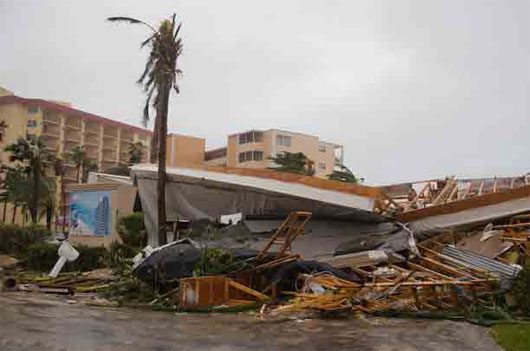Super Typhoon Haiyan struck the Philippines and is considered one of the strongest storms ever, with wind speeds reaching up to 315 km/h at times. In the past, there have been several storms with record wind speeds that did not cause significant damage.
12 Strongest Storms in History
- 1. Typhoon Tip – 1979
- 2. Super Typhoon Nora – 1973
- 3. Super Typhoon June – 1975
- 4. Super Typhoon Ida – 1958
- 5. Super Typhoon Kit – 1966
- 6. Super Typhoon Rita – 1978
- 7. Super Typhoon Vanessa – 1984
- 8. Hurricane Katrina – 2005
- 9. Super Typhoon Joan – 1959
- 10. Super Typhoon Irma – 1971
- 11. Super Typhoon Megi – 2010
- 12. Super Typhoon Haiyan – 2013
Historically, although Super Typhoon Yasi resulted in only one death, it is rated higher than Hurricane Katrina, which struck New Orleans with wind speeds of 280 km/h in 2005, causing 2,000 fatalities.
To date, there are no established standards for evaluating the strength of a storm, as storms with the highest wind speeds do not necessarily cause widespread destruction.

Typhoon Isabel captured from the International Space Station in 2003
However, the strength of a storm is often evaluated using pressure measurements. A storm that creates lower atmospheric pressure will typically cause more damage in the areas it passes through.
“There is a correlation between pressure and wind speed near the eye of the storm,” said Professor Kevin Walsh, a scientist at the University of Melbourne. Storms with lower pressure will draw in more wind towards the eye, resulting in more severe devastation.
Atmospheric pressure is measured in hectopascals (hPa). The standard atmospheric pressure at sea level is 1,013 hPa. The pressure during Super Typhoon Yasi was recorded at 930 hPa, while Hurricane Katrina produced a pressure of 902 hPa.
The most destructive storm ever recorded was in 1970 when Cyclone Bhola hit Bangladesh. Despite having a pressure of only 966 hPa, Bhola resulted in approximately 300,000 – 500,000 fatalities.
Here are the 10 largest storms recorded in world history:
1. Typhoon Tip – 1979
Typhoon Tip formed in 1979 near Micronesia in the western Pacific. With a record low atmospheric pressure of 870 hPa and a diameter of 2,200 km, Typhoon Tip broke all records for size and intensity in history. On October 12, 1979, Typhoon Tip formed over the Pacific with wind speeds of 305 km/h, but by the time it reached the mainland of Honshu, Japan, the winds had decreased to 130 km/h. Typhoon Tip triggered 600 landslides in Japan, destroyed 22,000 homes, and resulted in 86 fatalities.
2. Super Typhoon Nora – 1973
Super Typhoon Nora appeared east of the Philippines on October 1, 1973. The storm quickly intensified in four days with wind speeds of 298 km/h. The atmospheric pressure at that time was 877 hPa, the lowest ever recorded at that point. Super Typhoon Nora made landfall on the island of Luzon in the Philippines six days later. When the storm reached southeastern China on October 10, it had significantly weakened. Super Typhoon Nora caused 18 fatalities and approximately 2 million USD in damages.

Super Typhoon Yasi causing large waves and strong winds in Cairns
3. Super Typhoon June – 1975
Super Typhoon June was recorded in 1975 with maximum wind speeds reaching 297 km/h. Fortunately, the storm never made landfall and dissipated over the Pacific. Super Typhoon June was also the first storm to have three concentric circles around its eye.
4. Super Typhoon Ida – 1958
Ida formed in the western Pacific on September 20, 1958. The super typhoon quickly reached wind speeds of 321 km/h within just three days. However, by the time it reached Honshu, Japan, Super Typhoon Ida had weakened to 129 km/h. The storm brought heavy rain to southeastern Japan and destroyed two small villages. The heavy rainfall resulted in 888 fatalities and 1,900 landslides.
5. Super Typhoon Kit – 1966
Super Typhoon Kit formed in the Pacific on June 25, 1966. Reports confirmed that the storm reached wind speeds of 313 km/h, but at that time, wind measurement technology was still rudimentary. Super Typhoon Kit made landfall on Honshu on June 28, resulting in 64 deaths.
6. Super Typhoon Rita – 1978
Super Typhoon Rita appeared on October 15, 1978, but only reached wind speeds of 5 after eight days. The atmospheric pressure was measured at 878 hPa, 8 hPa less than the pressure of the strongest storm ever recorded. Super Typhoon Rita maintained this intensity for three days. As it made landfall in the Philippines, Super Typhoon Rita weakened. The exact death toll from Super Typhoon Rita has yet to be fully reported.
7. Super Typhoon Vanessa – 1984
Vanessa made landfall on Guam, a U.S. territory in the western Pacific, with wind speeds of 109 km/h. After passing Guam, the storm continued to strengthen, reaching wind speeds of 298 km/h. Super Typhoon Vanessa caused total damages of approximately 1.7 million USD on Guam.
8. Hurricane Katrina – 2005
Hurricane Katrina is considered one of the deadliest storms to hit the United States but ranks after Hurricane Wilma. Formed in the Caribbean Sea in October and moving southwest, Hurricane Wilma reached wind speeds of 296 km/h with a pressure of 885 hPa. Wilma made its initial landfall on the island of Cozumel in Mexico and continued moving deep inland. Hurricane Wilma caused the most severe damage in Florida, Mexico, and Cuba. The storm resulted in 62 fatalities and approximately 29 billion USD in damages.

Super Typhoon Wilma causing significant damage to the United States
9. Super Typhoon Joan – 1959
Super Typhoon Joan originated in the western Pacific. On August 28, 1959, Super Typhoon Joan reached wind speeds of 314 km/h. Just one day later, Super Typhoon Joan made landfall in Taiwan with wind speeds of 298 km/h. The storm moved through the Taiwan Strait before weakening and dissipating in China. Super Typhoon Joan caused severe flooding, destroyed 3,308 homes, and resulted in 14 fatalities.
10. Super Typhoon Irma – 1971
Super Typhoon Irma formed in the western Pacific but never made landfall. The strongest wind speed recorded was 290 km/h on November 11. The storm caused a dramatic drop in pressure from 981 hPa to 884 hPa within just one day.
11. Super Typhoon Megi – 2010
CNN reported that Typhoon Megi was one of the largest storms on the planet since 2005. The storm made landfall in northeastern Luzon, Philippines, in 2010, with speeds of 225 km/h.
After making landfall in the Philippines, Typhoon Megi gradually weakened but regained strength over the South China Sea. The storm wreaked havoc in three countries: the Philippines, Vietnam, and China, with estimated damages reaching 693.7 million USD.
Megi was the only super typhoon in 2010.
12. Super Typhoon Haiyan – 2013
Typhoon Haiyan made landfall in the Philippines in early November 2013, with wind speeds of 280-285 km/h. The storm caused the largest loss of life in Philippine history in recent times, with 6,300 fatalities.


















































